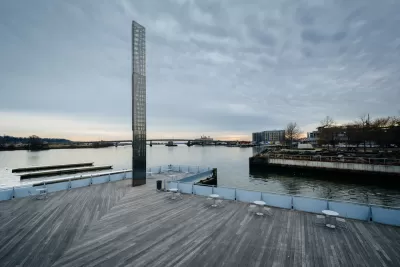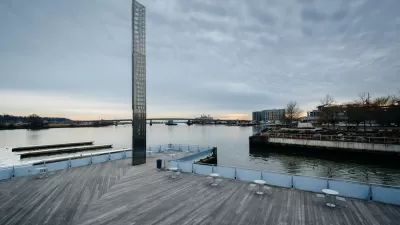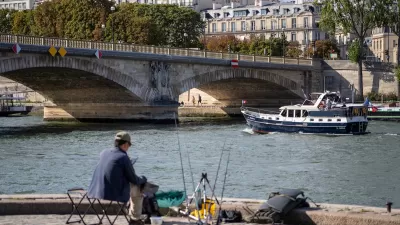The U.S. Army Corps of Engineers could soon study how to legalize swimming in the rivers around the nation’s capital—a scenario that would have seemed impossible in the not-too-distant past.

According to an article by Jacob Fenston, “someday in the not-too-distant future, going for a swim in the District’s rivers could be a real option on a hot summer day.”
“In the latest step toward making swimming in the city possible, the U.S. Army Corps of Engineers will conduct a feasibility study, identifying areas on the Potomac and Anacostia rivers where it’s clean enough and safe enough to swim,” according to Fenston. The study is contingent on President Joe Biden signing the Congress-approved 2022 Water Resources Defense Act.
The possibility of the Potomac and Anacostia rivers being clean enough for swimming first made the Planetizen newsfeed in 2018, when the grades for water quality, granted by local advocates, first crossed into passing territory for both rivers. At the time, the Potomac River’s grade was a B, and the Anacostia a D-. In 2020, the most recent grade for the Potomac River, the grade had slipped slightly to a B-. Unfortunately, the grade for the Anacostia had slipped back into fail territory. So, the efforts of the Army Corps of Engineers will be a welcome addition to the clean up effort.
The Potomac Riverkeepers launched a campaign earlier this year, documented in another article by Fenston, to legalize swimming in the Potomac River for the first time in 50 years.
Local advocates note that people are already going in the water around D.C., but formal legalization would help clear the way for recreational locations devoted to swimming.
FULL STORY: Splash! Army Engineers To Study Possible Swimming Beaches On D.C.’s Rivers

Alabama: Trump Terminates Settlements for Black Communities Harmed By Raw Sewage
Trump deemed the landmark civil rights agreement “illegal DEI and environmental justice policy.”

Study: Maui’s Plan to Convert Vacation Rentals to Long-Term Housing Could Cause Nearly $1 Billion Economic Loss
The plan would reduce visitor accommodation by 25% resulting in 1,900 jobs lost.

Why Should We Subsidize Public Transportation?
Many public transit agencies face financial stress due to rising costs, declining fare revenue, and declining subsidies. Transit advocates must provide a strong business case for increasing public transit funding.

Paris Bike Boom Leads to Steep Drop in Air Pollution
The French city’s air quality has improved dramatically in the past 20 years, coinciding with a growth in cycling.

Why Housing Costs More to Build in California Than in Texas
Hard costs like labor and materials combined with ‘soft’ costs such as permitting make building in the San Francisco Bay Area almost three times as costly as in Texas cities.

San Diego County Sees a Rise in Urban Coyotes
San Diego County experiences a rise in urban coyotes, as sightings become prevalent throughout its urban neighbourhoods and surrounding areas.
Urban Design for Planners 1: Software Tools
This six-course series explores essential urban design concepts using open source software and equips planners with the tools they need to participate fully in the urban design process.
Planning for Universal Design
Learn the tools for implementing Universal Design in planning regulations.
Smith Gee Studio
Alamo Area Metropolitan Planning Organization
City of Santa Clarita
Institute for Housing and Urban Development Studies (IHS)
City of Grandview
Harvard GSD Executive Education
Toledo-Lucas County Plan Commissions
Salt Lake City
NYU Wagner Graduate School of Public Service





























